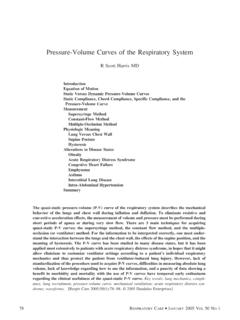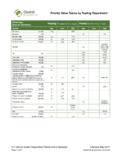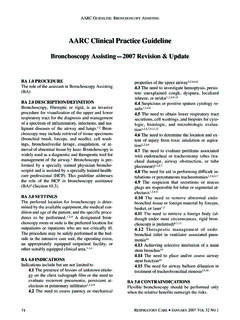Transcription of Pathophysiology of asthma - pneumonologia.gr
1 CHAPTER 5. Pathophysiology of asthma Barnes Correspondence: Barnes, Dept of Thoracic Medicine, National Heart and Lung Institute, Dovehouse St, London SW3 6LY, UK. asthma is characterised by a specific pattern of inflammation that is largely driven via immunoglobulin (Ig)E-dependent mechanisms. Genetic factors have an important influence on whether atopy develops and several genes have now been identified [1]. Most of the genetic linkages reported for asthma are common to all allergic diseases [2]. However, environmental factors appear to be more important in determining whether an atopic individual develops asthma , although genetic factors may exert an influence on how severely the disease is expressed and the amplification of the inflammatory response.
2 Inflammation It had been recognised for many years that patients who die from acute asthma attacks have grossly inflamed airways. The airway lumen is occluded by a tenacious mucus plug composed of plasma proteins exuded from airway vessels and mucus glycoproteins secreted from surface epithelial cells. The airway wall is oedematous and infiltrated with inflammatory cells, which are predominantly eosinophils and lymphocytes. The airway epithelium is invariably shed in a patchy manner and clumps of epithelial cells are found in the airway lumen.
3 Occasionally there have been opportunities to examine the airways of asthmatic patients who die accidentally and similar though less marked inflammatory changes have been observed [3]. More recently it has been possible to examine the airways of asthmatic patients by fibreoptic and rigid bronchoscopy, by bronchial biopsy and by bronchoalveolar lavage (BAL). Direct bronchoscopy reveals that the airways of asthmatic patients are often reddened and swollen, indicating acute inflammation. Lavage has revealed an increase in the numbers of lymphocytes, mast cells and eosino- phils and evidence for activation of macrophages in comparison with nonasthmatic controls.
4 Biopsies have revealed evidence for increased numbers and activation of mast cells, macrophages, eosinophils and T-lymphocytes [4, 5]. These changes are found even in patients with mild asthma who have few symptoms, and this suggests that asthma is an inflammatory condition of the airways. Inflammation is classically characterised by four cardinal signs: calor and rubor (due to vasodilatation), tumour (due to plasma exudation and oedema) and dolor (due to sensi- tisation and activation of sensory nerves. It is now recognised that inflammation is also characterised by an infiltration with inflammatory cells and that these will differ depending on the type of inflammatory process.)
5 Inflammation is an important defence response that defends the body against invasion from microorganisms and against the effects of external toxins. The inflammation in allergic asthma is characterised by the fact that it is driven by exposure to allergens through IgE-dependent mechanisms, resulting in a characteristic pattern of inflammation. This allergic inflammatory response is characterised by an infiltration with eosinophils and resembles the inflammatory process mounted in response to parasitic and worm infections.
6 The inflammatory response not Eur Respir Mon, 2003, 23, 84 113. Printed in UK - all rights reserved. Copyright ERS Journals Ltd 2003; European Respiratory Monograph;. ISSN 1025-448x. ISBN 1-904097-26-x. 84. Pathophysiology OF asthma . only provides an acute defence against injury, but is also involved in healing and restoration of normal function after tissue damage as a result of infection of toxins. In asthma , the inflammatory response is activated inappropriately and is harmful rather than beneficial. For some reason allergens, such as house dust mite and pollen proteins, induce an eosinophilic inflammation.
7 Normally such an inflammatory response would kill the invading parasite (or vice versa) and would therefore be self-limiting, but in allergic disease the inciting stimulus persists and the normally acute inflammatory response becomes converted into a chronic inflammation which may have structural consequences in the airways and skin. Intrinsic asthma Although the majority of patients with asthma have atopy, in a proportion of patients with asthma there is no evidence of atopy with normal total and specific IgE and negative skin tests.
8 This so-called "intrinsic" asthma usually comes on later in life and tends to be more severe than allergic asthma [6]. The Pathophysiology is very similar to that of allergic asthma and there is increasing evidence for local IgE production, possibly directed at bacterial or viral antigens [7]. Inflammation and airway hyperresponsiveness The relationship between inflammation and clinical symptoms of allergy is not yet clear. There is evidence that the degree of inflammation is related to airway hyper- responsiveness (AHR), as measured by histamine or methacholine challenge.
9 Increased airway responsiveness is an exaggerated airway narrowing in response to many stimuli and is the defining characteristic of asthma . The degree of AHR is related to asthma symptoms and the need for treatment. Inflammation of the airways may increase airway responsiveness which thereby allows triggers which would not narrow the airways to do so. But inflammation may also directly lead to an increase in asthma symptoms, such as cough and chest tightness, by activation of airway sensory nerve endings (fig. 1).
10 Allergens Sensitisers Viruses Air pollutants? Inflammation Airway Chronic eosinophilic Hyperresponsiveness bronchitis Triggers Allergens Symptoms Exercise Cough Wheeze Cold air Chest Dyspnoea SO2. tightness Particulates Fig. 1. Inflammation in the airways of asthmatic patients leads to airway hyperresponsiveness and symptoms. Th2: T-helper 2 cells; SO2: sulphur dioxide. 85. BARNES. Persistence of inflammation Although most attention has focused on the acute inflammatory changes seen in asthma , this is a chronic condition, with inflammation persisting over many years in most patients.



![Pneumonia (Ventilator-associated [VAP] and non …](/cache/preview/d/3/6/5/6/9/b/6/thumb-d36569b6dc8a7d8c6714d2f268ee79b7.jpg)




